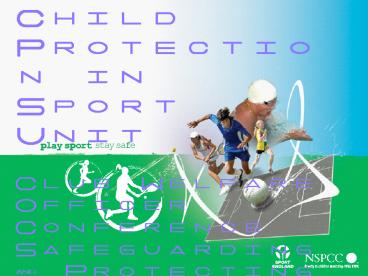Child Protection in Sport Unit - PowerPoint PPT Presentation
1 / 18
Title:
Child Protection in Sport Unit
Description:
Safeguarding the welfare of children is about best practice in sport ... proposed Independent Safeguarding Authority scheme - formerly Vetting & Barring) ... – PowerPoint PPT presentation
Number of Views:223
Avg rating:3.0/5.0
Title: Child Protection in Sport Unit
1
Child Protection in Sport Unit Club Welfare
Officer Conference Safeguarding Protecting
Children in Rugby League 27 July 2008 Gill
Joyce National Development Officer
2
Child Protection in Sport
- Children have the right to have fun and be safe
in sport - Safeguarding the welfare of children is about
best practice in sport - Sport provides easy access to someone who wants
to harm children - Close proximity of coaches, intense and
competitive atmosphere places children and adults
in vulnerable situations - Sport is uniquely placed to contribute to
safeguarding the welfare of children
3
Safeguarding in Context
- Background
- January 2003
- - Inquiry report into the death of Victoria
Climbié - - Every Child Matters
- Change for Children - Green Paper
- - What to do if you are Worried a Child is
Being Abused
4
Safeguarding in Context
- 2004
- - Every Child Matters Next steps and final
strategy - - Bichard Inquiry Report following the
conviction of Ian Huntley for the murders of
Holly Wells and Jessica Chapman - - The Children Act 2004
5
Safeguarding in Context
- 2006
- Revised Working Together to Safeguard Children
2006 (statutory guidance for all organisations
working with children) - - Safeguarding Vulnerable Groups Act
2006 - (allows for establishment of proposed
Independent Safeguarding Authority scheme -
formerly Vetting Barring)
6
Every Child Matters
- Every Child Matters Change for Children Dec
2004 - A major strategy to improve outcomes for children
(all children, but emphasis on reducing gap
between disadvantaged children others) - Supported by legislation, guidance and plans
- Improving outcomes for children young people
means engaging all those who have an impact on
children's lives. Voluntary community
organisations have a crucial role to play.
7
Five key outcomes for all children young people
- Be healthy
- physical and mental health and well-being
- Stay safe
- protection from harm and neglect
- Enjoy and achieve
- education, training and recreation
- Make a positive contribution
- the contribution made by them to society
- Achieve economic well-being
- social and economic well-being
8
Working Together to Safeguard Children2006
- Everybody who works with children, parents and
other adults in contact with children should be
able to recognise and know how to act upon
indicators that a childs welfare or safety may
be at risk. - Employers of staff or volunteers who have
substantial unsupervised access to children
should guard against the potential for abuse,
through rigorous selection processes, appropriate
supervision and by taking steps to maintain a
safe appropriate environment for children. - Section 2.8 requirements on all organisations
providing services for children (whether
statutory, voluntary or private)
9
Statutory duties, roles and responsibilities for
all organisations Working Together to Safeguard
Children 2006 2.8
Senior management commitment
Priorities in strategic policy documents
Clear lines of accountability
Policies and procedures for safeguarding children
including CP policy and procedures
Effective recruitment selection procedures
including Safeguarding checks
Safeguarding Promoting Childrens Welfare
Procedures for dealing With allegations
against Staff / volunteers
Arrangements for staff / volunteer training
Whistle blowing Procedures and culture
Arrangements for working with other
organisations including information sharing
Culture of listening to children
10
Standards for Safeguarding Protecting Children
in Sport
11
Codes of Practice Behaviour
Communication
Equity
Access to Advice Support
Education Training
Procedures Systems
Prevention
Implementation Plan
Policy
12
Safeguarding StandardsRFL Intermediate Level
- This is an exemplary example of how the standards
are owned and implemented by a National Governing
Body. Rugby Football League have a sound child
protection policy and procedure in place with a
clear implementation strategy throughout all
levels of the organisation. The commitment from
the RFL to safeguarding children in sport is to
be commended. - Standards Assessment Panel
- March 2007
13
Team Australia
14
Key Messages
- Importance and value for children the sport
- Set the tone at club level
- Pro-active
- Competent and Confident
- Knowledge
- Skills
- Training
- Resources
- Empowered committee members
- Supported
15
Where are we now?
- Clarity of roles and responsibilities across
the organisation - OWNERSHIP at all levels
- Review, update and revision of existing
policies, procedures guidance documents - Update of recruitment/selection plans including
CRB disclosure monitoring - Improved communication
- Child protection training strategy
16
Where are we now?
- Mandatory review of Club Welfare Officers
- Regional Welfare Officer network now established
- CWO Time to Listen training now rolling out
- Anticipated increase in referrals expected from
August - Submission against Advanced level of Safeguarding
Standards by December 2008 - Culture of Listening to Children how do we do
this, why is it important?
17
Terms of Reference for the CPSU First point of
contact - one stop shop approach for
- The production and provision of information,
training and resources for sport - Commissioning support of research into best
practice - Development of effective and efficient cross
sport standards, structures and systems - Specialist support and advice on practice
(including expert advice on cases) and the
development and implementation of CP policies - Duty helpline / NSPCC and Childline helplines
- Raising profile of safeguarding welfare
issues and influencing change - Monitoring and evaluation
18
- www.thecpsu.org.uk
- Tel 0116 234 7278
- www.everychildmatters.co.uk
- www.crb.co.uk































